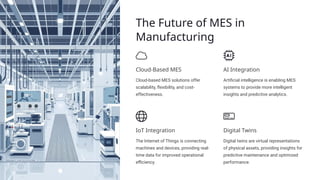Introduction to MES System Introduction to MES System
- 1. Introduction to MES System Welcome to the world of MES systems! Discover how these powerful tools are transforming the way manufacturers optimize their operations and achieve greater efficiency.
- 2. What is a Manufacturing Execution System (MES)? 1 Real-time Control MES systems provide a centralized hub for monitoring and managing production processes, enabling real- time insights into operational performance. 2 Data Collection They gather data from various sources within the factory floor, including machines, sensors, and operators, providing a comprehensive view of production activities. 3 Process Optimization MES systems empower manufacturers to identify bottlenecks, improve resource allocation, and optimize production flows, leading to greater efficiency and productivity.
- 3. Key Components of an MES Data Acquisition Collecting data from various sources on the factory floor, such as machines, sensors, and operators. Data Processing Analyzing and interpreting data collected from the production floor to provide valuable insights and actionable intelligence. Data Visualization Presenting processed data in a user- friendly format through dashboards and reports to support informed decision- making.
- 4. Benefits of Implementing an MES Increased Productivity MES systems help optimize production processes, minimizing downtime and maximizing output. Reduced Waste By monitoring and controlling production processes, MES systems help minimize material waste and improve resource utilization. Improved Quality MES systems enable manufacturers to track and control product quality, ensuring consistency and minimizing defects. Enhanced Traceability MES systems provide detailed tracking of products throughout the manufacturing process, enabling seamless traceability and recall management.
- 5. Common MES Functionalities 1 Production Scheduling Optimizing production plans and schedules based on real- time data and demand forecasts. 2 Quality Management Monitoring and controlling product quality throughout the manufacturing process to ensure consistency and meet standards. 3 Inventory Control Managing and tracking inventory levels, minimizing stockouts and optimizing material flows. 4 Workforce Management Tracking and managing employee activities, including tasks, performance, and training. 5 Reporting and Analytics Generating reports and dashboards to provide valuable insights into production performance and identify areas for improvement.
- 6. Challenges in MES Implementation Legacy System Integration Integrating MES systems with existing legacy systems can be complex and time- consuming. Data Integration Ensuring data consistency and accuracy across various systems and sources. Change Management Overcoming resistance to change from employees and management. Implementation Costs MES implementation can involve significant upfront costs, requiring careful planning and budgeting.
- 7. Case Studies: MES Success Stories Industry Challenge Solution Results Automotive Production delays and quality issues MES implementation for production scheduling and quality control Reduced lead times, improved quality, and increased customer satisfaction Pharmaceuticals Compliance and regulatory challenges MES for batch tracking, documentation, and regulatory compliance Improved compliance with industry regulations and reduced risk of product recalls Electronics Inventory management issues and material shortages MES for inventory control, material planning, and supply chain optimization Reduced inventory costs, improved supply chain efficiency, and minimized production downtime
- 8. The Future of MES in Manufacturing Cloud-Based MES Cloud-based MES solutions offer scalability, flexibility, and cost- effectiveness. AI Integration Artificial intelligence is enabling MES systems to provide more intelligent insights and predictive analytics. IoT Integration The Internet of Things is connecting machines and devices, providing real- time data for improved operational efficiency. Digital Twins Digital twins are virtual representations of physical assets, providing insights for predictive maintenance and optimized performance.







